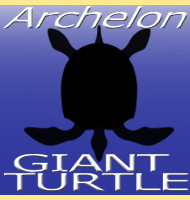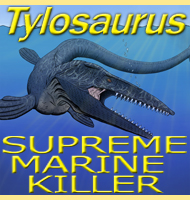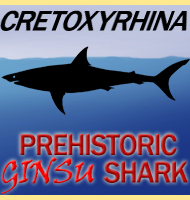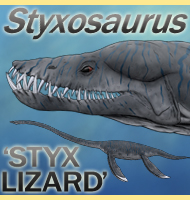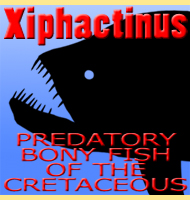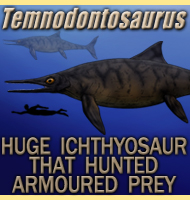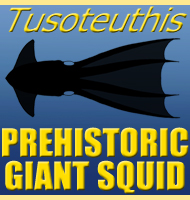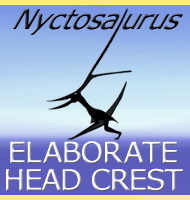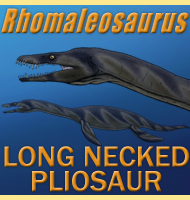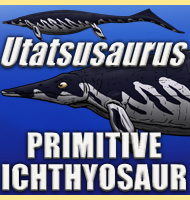


Polycotylus
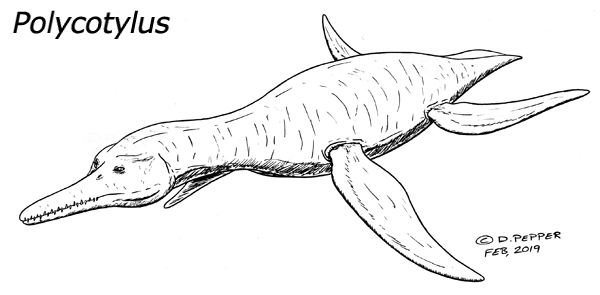
Name:
Polycotylus
(very cupped vertebra).
Phonetic: Pol-e-cot-e-lus.
Named By: Edward Drinker Cope - 1869.
Classification: Chordata, Reptilia,
Sauropterygia, Plesiosauria, Polycotylidae, Polycotylinae.
Species: P. latipinnis
(type), P. dolichops, P. ichthyospondylus, P.
ischiadicus, P. sopozkoi, P. suprajurensis, P. tenius.
In
addition to these, P. balticus, P. brevispondylus,
P. epigurgitis, P. orientalis, P. ultimus, P. donicus
are sometimes mentioned but these have all also been treated as nomen
dubia.
Diet: Piscivore/Carnivore.
Size: Around 5 meters long, but size is
dependent upon species.
Known locations: Australia, North America and
Russia.
Time period: Late Cretaceous.
Fossil representation: Many individuals.
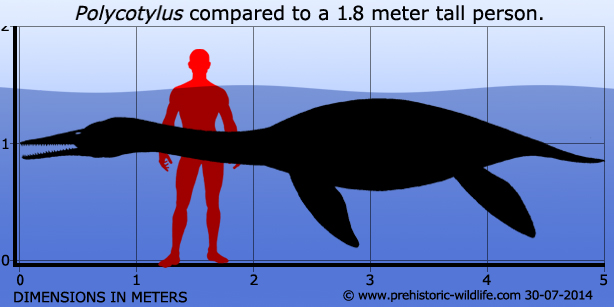
In
the early days of plesiosaur
evolution back in the Jurassic, there
were two main groups that were successful enough to become two of the
main kinds of marine reptiles of the Mesozoic. These were long necked
plesiosaurs such as Plesiosaurus
and Cryptoclidus,
and short necked
pliosaurs
(technically a sub group of plesiosaurs) such as
Pliosaurus
and Liopleurodon.
For a time these two groups were very
successful but by the later stages of the Mesozoic, both groups had
waned with the short necked pliosaurs becoming particularly rare.
It was now that a new kind of plesiosaur called a polycotylid emerged
to fill a void left by the disappearance of other marine reptiles
such as ichthyosaurs
that resulted in a body shape reminiscent of the
dwindling pliosaurs.
Polycotylus
is the type genus of the Polycotylidae, the family group of these new
kinds of plesiosaurs that appeared in the Cretaceous. Polycotylus
had
a body similar to those of its ancestors, though the key differences
between them are that Polycotylus had a much
shorter neck but longer
jaws. Whereas the long-necked plesiosaurs used their necks to gain a
reach advantage when hunting prey like fish, Polycotylus
relied more
upon speed and manoeuvrability to chase down its prey. Despite the
shorter neck however, Polycotylus still retained
a reasonably large
number of neck vertebrae. While this might have offered increased
flexibility for the neck, later polycotlids would develop similarly
proportioned necks but with a reduced number of vertebrae.
In
the 1980s a specimen of the type species P. latipinnis
(later
classified as LACM 129639) was found along with a foetus that was
about forty percent the length of its mother. This revealed two
things, the first being that plesiosaurs did give birth to live young
instead of laying eggs. This was not a huge revelation since most
palaeontologists were already of the opinion that plesiosaurs gave
birth to live young because of the difficulties they would have faced
when moving without the buoyancy of water to support their body
weight. Additionally their earlier relatives the nothosaurs
are also
known to have given birth to live young with such genera as Lariosaurus
and Keichousaurus.
The ichthyosaurs
are also known to have given
birth to live young, and even some modern reptiles such as sea snakes
and even the land living viviparous lizard (Zootoca vivipara)
give
birth to live young instead of laying eggs.
The
second is that plesiosaurs like Polycotylus almost
certainly employed a
K-strategy survival method when raising young. What this means is
that only a very small number of young are raised by an individual
throughout their lifetime, but the parent makes a long term
investment in raising and protecting the young so that they have a
better chance of making it to adulthood. This is a stark contrast to
the r-strategy method usually employed by reptiles we know today where
a large number of young are raised but are not given extended care and
protection by the parents. Not many young born this way survive to
adulthood, but the sheer numbers involved ensure the survival of the
species.
As
already mentioned, Polycotylus is the type genus
of the
Polycotylidae, and other plesiosaurs that are members of this include
Dolichorhynchops,
Edgarosaurus,
Eopolycotylus,
Palmulasaurus
and
Trinacromerum
amongst many others.
Further reading
- On some reptilian remains. - The American Journal of Science, series
2 48:278. - E. D. Cope - 1869.
- Notes sur les reptiles fossiles [Notes on fossil reptiles]. -
Bulletin de la Soci�t� G�ologique de France, 3e s�rie 4:435-444. - H.
-E. Sauvage - 1876.
- On the cranial anatomy of the polycotylid plesiosaurs, including new
material of Polycotylus latipinnis, Cope, from
Alabama. - Journal of
Vertebrate Paleontology 24 (2): 326–34. - F. R. O. Keefe - 2004.
- Plesiosaurs from the Upper Cretaceous (Cenomanian-Turonian) Tropic
Shale of southern Utah, Part 2: Polycotylidae. - Journal of Vertebrate
Paleontology. 27 (1): 41–58. - L. B. Albright III, D. D. Gillette
& A. L. Titus - 2007.
-A New Species of the Plesiosaur Genus Polycotylus from the Upper
Cretaceous of the Southern Urals". Paleontological Journal. 50 (5):
494–503. - A New Species of the Plesiosaur Genus Polycotylus from the
Upper Cretaceous of the Southern Urals. - Paleontological Journal. 50
(5): 494–503. - V.M. Efimov, I.A. Meleshin & A.V. Nikiforov -
2016.
- Ontogeny of Polycotylid Long Bone Microanatomy and Histology. -
Integrative Organismal Biology. 1. - F. R. O’Keefe, P M Sander, T
Wintrich & S Werning - 2019.
----------------------------------------------------------------------------
Random favourites
 |
 |
 |
 |
